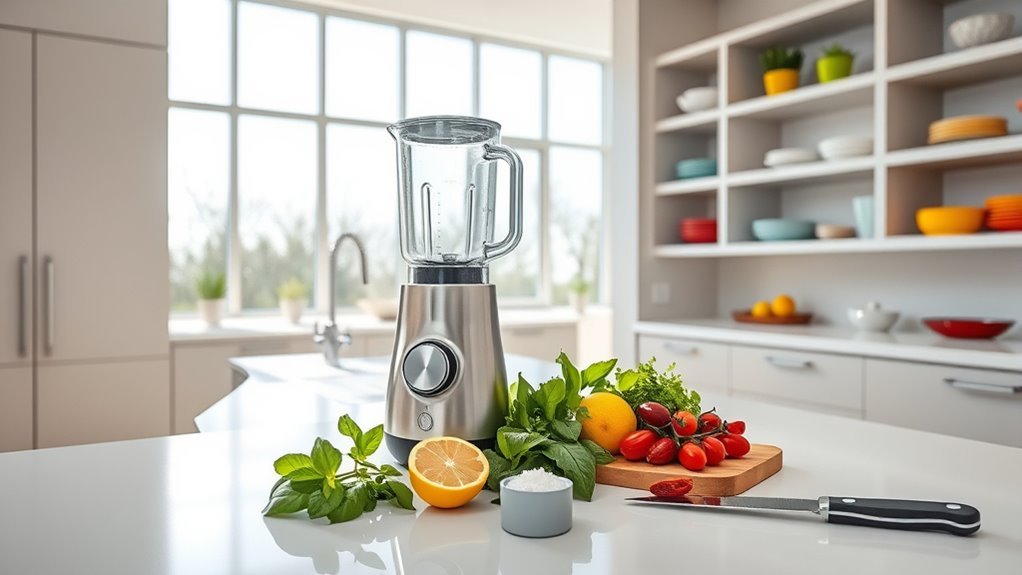Quick bursts create perfect salad dressings by forcing oil droplets to disperse evenly throughout vinegar. We’re using controlled chaos here – those 1-second pulses with short rests break down oil into microscopic particles while preventing over-mixing. The key’s in the timing: too long and it separates, too short and it won’t emulsify. Add an emulsifier like mustard first, then pulse while slowly drizzling oil. There’s a whole science to this controlled mayhem.
The Science Behind Quick Burst Emulsification

Why do some salad dressings hold together perfectly while others separate into sad, oily layers? It’s all about mastering quick bursts of physical agitation when making homemade dressings.
We’re basically playing matchmaker between oil and vinegar – two ingredients that naturally resist each other. Quick bursts in a blender or vigorous shaking create temporary chaos, forcing oil droplets to disperse evenly throughout the liquid.
This emulsification process gives us the smooth, creamy texture we’re after. Add emulsifying agents like mustard, and we’ve got stability on our side.
The key? Don’t overdo it. Short bursts maintain the perfect balance, preventing the dreaded breakdown that leads to separation.
The result? A beautifully cohesive dressing that stays mixed and ready to elevate any salad.
Mastering Pulse Techniques for Perfect Dressings
Understanding pulse techniques can make or break your salad dressing game. When we’re creating homemade vinaigrette, controlled bursts of blending are essential for a stable dressing that won’t break apart.
Pulse techniques create smaller oil droplets, increasing surface area and enhancing emulsification between oil and vinegar.
- Use 1-second pulses, waiting 2-3 seconds between each burst to monitor consistency
- Start with a solid base (mustard, garlic, herbs) before adding oil in a thin stream while pulsing
- Watch for visual cues – when the mixture turns slightly cloudy, you’re achieving proper emulsification
Let’s face it: nobody wants a separated vinaigrette.
Essential Equipment and Ingredients for Burst Blending

Equipment mastery separates mediocre dressings from spectacular ones.
We’ll need either a high-speed blender or food processor as our essential equipment – no compromises here. These powerhouses create the perfect environment for emulsion magic.
Let’s talk ingredients: We’re combining acidic components like vinegar with emulsifiers (Dijon mustard’s our go-to) and a strategic oil blend.
Start with your aromatics – crush that garlic and herbs first. Then splash in your acids, and here’s the critical part: drizzle oil slowly while blending. We’re creating a micro-emulsion that won’t dare separate.
Quick bursts are your secret weapon. They trap air precisely where we need it, transforming ordinary ingredients into a creamy salad dressing that holds its structure. High-performance blenders, with motor power over 1,000 watts, ensure that you achieve that perfect emulsion every time.
Master this technique, and you’ll never look back.
Common Mistakes in Quick-Burst Mixing Methods
Despite mastering burst-blend techniques, we’re seeing home cooks sabotage their dressings through five critical mixing errors. When using a high-speed blender, quick bursts must be precisely timed to prevent oil and vinegar separation.
We’ve noticed these mistakes derailing otherwise perfect emulsions.
- Not gradually incorporating oil during quick bursts leads to coarse, broken textures
- Failing to evenly distribute emulsifying agents like mustard before blending compromises stability
- Excessive mixing causes unwanted aeration, ruining the final consistency
Let’s be clear: monitor consistency throughout the process. Quick bursts need control – too much blending breaks the emulsion, too little leaves it unstable.
Trust us, proper timing is everything. Master these points, and you’ll nail that silky-smooth texture every time.
Advanced Tips for Stable Emulsion Results

Now that you’ve learned what not to do, let’s focus on the techniques that’ll guarantee your emulsions stay together.
We’ll start with the foundation: maintaining a 3:1 ratio of oil to vinegar. It’s non-negotiable.
Here’s your game plan: Add emulsifying agents like Dijon mustard first – they’re your insurance policy against separation.
Then, release those quick bursts with your immersion blender while slowly drizzling in the oil. We’re talking tablespoon-by-tablespoon precision here. Properly whisking or blending creates smaller oil droplets that stay suspended longer.
Watch that texture – your salad dressing should develop a creamy consistency that screams stability.
If you’re seeing immediate separation, you’re adding oil too fast. Slow down. Your patience will pay off.
Frequently Asked Questions
Why Is Salad Dressing an Emulsion?
We’re mixing two liquids that don’t usually combine – oil and vinegar – through emulsification. When we blend them, thousands of tiny oil droplets suspend in the vinegar, creating a stable, flavorful dressing.
What Ingredient Makes the Dressing Emulsify More Easily?
We’ll find emulsifying agents like Dijon mustard, egg yolks, and honey make dressings blend more easily. These ingredients prevent oil and vinegar from separating, creating smoother, more stable dressings.
How to Get Salad Dressing to Emulsify?
We’ll get perfect emulsion by slowly whisking oil into vinegar at a 3:1 ratio, adding emulsifying agents like mustard, and using quick bursts in a blender for ideal ingredient dispersal.
Why Does My Homemade Salad Dressing Congeal in the Fridge?
Just like butter firms up in the fridge, our olive oil-based dressings solidify when chilled. We can prevent this by blending in neutral oils or letting it sit briefly before serving.

